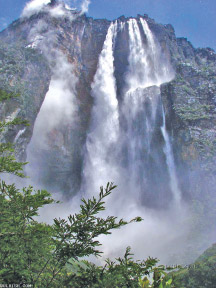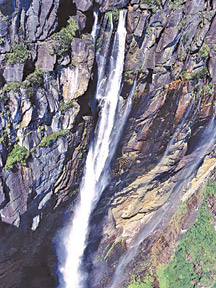

Angel Falls has an upper section where it emerges briefly from the
slot canyon, plunges 100 feet or so and then goes into a cave or a
crevice and emerges again below about 150 feet or so to take the long
drop. It is extremely treacherous to move around in this area as even
the short drop would kill you easily X3. You have to be anchored down
when standing around the top of the falls.
|

A side view of the breathtaking Fall |
That leads to the second consideration, that the falls at high water
creates its own weather. There are tremendous gusts of wind and waves of
spray that is created by the first and second part of the falls crashing
against the rocks and into the cave. Great gusts of wind emerge both
above and below the cave. It is a pretty unique situation as you might
expect from the world's highest waterfalls.
From a distance you only see one great fall, but close up you can see
a series of canyons, tunnels, and caves into which the falls enter and
emerge several times at the top.
In medium or high water this area is extremely violent with high
unpredictable winds and waves of spray.
|

The gushing waters of Angels Falls |
The base jumpers always jump at low water to avoid the high winds.
Some of the best jumpers in the world jumping under the very best of
conditions have been killed there anyway.In the western part of Canaima
National Park, is the Auyantepuy, one of the largest and better known "tepuy"
(A flat top mountain ending with vertical walls).
From this tepuy is where the Angel falls are formed. The fall is 979
metres high (around 3,000 ft.), and is the highest waterfall in the
world.
The Angel Falls were named after the american aviator who discovered
them in 1937. However, the local indians, the Pemones, already knew it
and called it the Churún Merú. Angel falls spills from the Auyantepui
into what is known as the Devil's canyon 979 metres below.
The local indians call it Kerepakupai-merú but is was named Angel
Falls after Jimmy Angel, an American bush pilot and gold-hunting
adventurer, who discovered it in 1937. The waters fall freely some 807
metres (2,648 feet) and reach the bottom of the valley as a misty spray
that gathers into a small creek which eventually finds its way into the
north-bound Churun River.
The Natives in Venezuela had known about the "Salto Angel" since the
beginning of time. United States pilot Jimmie Angel was flying over the
area in 1935 when he landed on the top of a lone mountain in search of
gold.
- Internet |


